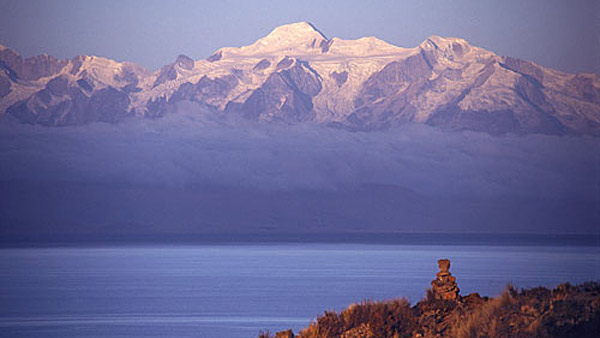
|  |  |  Editorials | Environmental | November 2009 Editorials | Environmental | November 2009  
Global Warming Threatens Lake Titicaca, Imperils Millions of Bolivians
 Univision.com Univision.com
go to original
November 17, 2009


| | Lake Titicaca was the life source of the Incan and Tiwanaku civilizations, whose monuments still stand today in villages where people live off the lake and the surrounding lands. (sacredsites.com) |  |
La Paz, Bolivia - Global warming has accelerated the evaporation of Lake Titicaca, the water level of which has dropped to the lowest point in years, Carlos Andrade, of the Binational Autonomous Authority of Lake Titicaca (ATL), told The Associated Press last week.

"Water levels have fallen 88 cm (nearly 3 feet) this year, far exceeding normal lows," Andrade said. "This is the biggest loss in decades, and it is definitely attributable to global warming," he added.

Thirty-seven miles west of La Paz, Titicaca is a natural wonder: 3,232 square miles of water sitting 2.3 miles up in the Andean Altiplano (highlands). The lake is shared between Bolivia and Peru, and is a major tourist draw. It recently competed to become one of the "New Seven Wonders of the World," but was not selected to be among the finalists.

Lake Titicaca is fed by rain and meltwater from the mountains, but much of the water is being lost at an increased rate due to a rise in solar radiation in the thin Andean atmosphere. Climate disruptions from global warming have also reduced the rainy season from six to three months, said Félix Trujillo, chief of Bolivia's National Meteorological and Hydrological Service.

Large swaths of land, especially in the Andean regions of Bolivia, are experiencing prolonged periods of drought, and the lack of precipitation has jeopardized the water supply of several Bolivian cities, added Trujillo.

A little over half of the Bolivian population, estimated at ten million, live in the Andean highlands, and they rely on meltwater from the mountains for their water supply.

Trujillo said that the rainy season will begin in mid-November this year, but expects that the rains could recede as soon as December. The lack of rain would be accompanied by a heat wave that would speed up the evaporation of reservoir water. This scenario would increase the demand and decrease the supply of potable water.

Environment Minister René Orellana said that Bolivia will need to invest $1 billion over the next seven years to construct dams and ensure an adequate water supply. Experts from ATL are currently looking into the construction of a system of floodgates that would regulate water levels between the upper and lower basins of Lake Titicaca, said Carlos Andrade.

The regions that have been hardest hit by the drought have been the Altiplano in the west, and Chaco in the south, where local authorities have already reported the deaths of thousands of cattle.

Lake Titicaca was the life source of the Incan and Tiwanaku civilizations, whose monuments still stand today in villages where people live off the lake and the surrounding lands. |

 |
|  |



